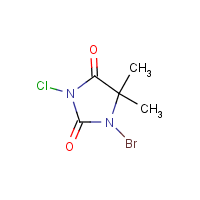1-Bromo-3-chloro-5,5-dimethylhydantoin
Agent Name
1-Bromo-3-chloro-5,5-dimethylhydantoin
CAS Number
16079-88-2
Formula
C5-H6-Br-Cl-N2-O2
Major Category
Other Uses

Synonyms
Di-Halo; 1-Bromo-3-chloro-5,5-dimethyl-2,4-imidazolidinedione; 2,4-Imidazolidinedione, 1-bromo-3-chloro-5,5-dimethyl-; Agribrom; Halogene T 30; N-Bromo-N'-chloro-5,5-dimethylhydantoin; Slimicide 78P; Slimicide C 77P; 1-Bromo-3-chloro-5,5-dimethylimidazolidine-2,4-dione; Hydantoin, 1-bromo-3-chloro-5,5-dimethyl-; [ChemIDplus]
Category
Biocides/Disinfectants
Description
White solid; [HSDB] Faintly yellow fine crystals; [Aldrich MSDS]
Sources/Uses
Used as germicide and fungicide for water treatment (industrial, spas, and hot tubs); Also used as disinfectant, halogenating agent, ionic catalyst, and selective oxidant; [HSDB] Halohydantoins: Used as disinfectants in swimming pools, hot tubs, toilet bowls, and industrial systems (cooling water, pulp and paper, wastewater, and sewage); Also used as slimicide for paper/paperboard for food contact; [Reference #1]
Comments
Dissolves in water creating 5,5-dimethylhydantion plus the two active products, hypobromous acid and hypochlorous acid; Corrosive to skin and eyes; May cause skin burns and vision loss; 5,5-Dimethylhydantoin: No adverse effects observed (hematology, clinical chemistry, pathology, tumor frequency, etc.) besides decrease in survival time in two year feeding study of rats with maximum dose of 1000 mg/kg/day; Adrenal cortical hypertrophy and increased relative adrenal weight observed in male dogs at 40000 ppm in one year feeding study; No reproductive effects observed in multigenerational feeding study of rats; No evidence of carcinogenicity or mutagenicity; [HSDB] Halohydantoins: The persistent metabolites, 5,5-Dimethylhydantoin (DMH) and 5-Ethyl-5-methylhydantoin (EMH), are used for developing toxicity data for this group of compounds; Quickly decomposed by water forming hypochlorous or hypobromous acid (the true biocidal agents) and DMH or EMH; Severely irritating to rabbit skin; A skin sensitizer in guinea pigs; DMH/EMH: Sub-chronic, developmental, reproductive, and chronic toxicity animal studies have shown non-specific toxicity at high doses (no evidence of carcinogenicity, reproductive or developmental toxicity, and limited evidence of mutagenicity); [Reference #1] An oxidizer that may cause fire on contact with combustible materials; Causes burns; Inhalation may cause corrosive injuries to upper respiratory tract and lungs; Harmful by ingestion; [Aldrich MSDS] See "1,3-Dichloro-5,5-dimethylhydantoin."
Reference Link #1
Biomedical References
Exposure Assessment
Vapor Pressure
6.61E-06 mm Hg
Lethal Concentration
LC50 (rat) = 168 mg/m3
Reference Link #2
Adverse Effects
Skin Sensitizer
Yes
Dermatotoxin
Skin burns
Diseases, Processes, and Activities Linked to This Agent
Diseases
Occupational diseases associated with exposure to this agent:
Processes
Industrial Processes with risk of exposure: